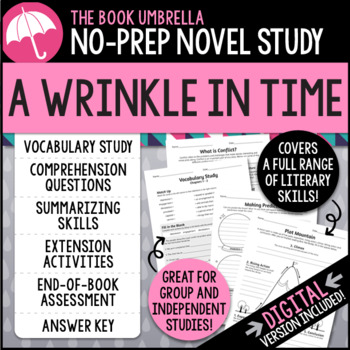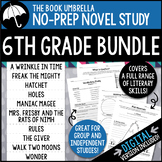A Wrinkle in Time Novel Study { Print & Digital }
- Zip
- Google Apps™

What educators are saying
Also included in
- This bundle includes 10 of our novel studies selected for sixth grade students in printable and digital formats.The 10 novel studies included in this bundle are:• A Wrinkle in Time• Freak the Mighty• Hatchet• Holes• Maniac Magee• Mrs. Frisby and the Rats of Nimh• Rules• The Giver• Walk Two Moons• WoPrice $64.75Original Price $92.50Save $27.75
Description
This is a novel study for A Wrinkle in Time by Madeleine L'Engle. Includes printable and digital versions. 48 pages of student work, plus an answer key! This novel study divides A Wrinkle in Time into six sections for study. The chapters are grouped as follows: Chapter 1-2, 3-4, 5-6, 7-8, 9-10, 11-12.
Includes the following:
• A Wrinkle in Time novel study title page for students
• Dictionary Look-up sheets (6 total)
• Vocabulary Study sheets (6 total)
• Understanding the Story comprehension worksheets (6 total)
• Chapter Summary worksheets (6 total)
• Time for a Test! assessment sheets (2 pages - includes multiple choice, short answer and long answer questions)
• 20 Comprehension worksheets (includes Before Reading, Author Research, Character Chart, Making Predictions, Plot Mountain, Story Timeline, Conflict, Setting, Theme, Problem Solving, Cause and Effect, Character Types, Character Map, Facts and Opinions, Persuasive Writing, Quotations, Character Comparison, Story Comparison, Making Connections)
• Reading Log for students to record novels read
• Answer key - 14 pages (for the Vocabulary Study, Understanding the Story, and test pages)
• Outline of Common Core standards met for grades 5 - 8
Bonus Digital Version - Google Classroom compatible!
Included in the download are PowerPoint files for each section of the novel study. Use these files right in PowerPoint, or upload them to your Google Drive / Google Classroom account to share with your students! Your students will be able to fill in their answers and submit their work, all online.
Please note that the print and digital versions are not identical. The digital versions of our novel studies have mostly the same content as our print versions, but the format of some activities differ in order to make them easier for students to complete digitally, and some questions and activities have been altered or eliminated. For example, drawing activities have been eliminated.
Aligned to common core - RL5.1, RL5.2, RL5.3, RL5.4, L5.4, L5.5, RL 6.1, RL6.2, RL6.3, RL6.4, RL6.5, L6.4, L6.5, L6.6., RL7.1, RL7.2, RL7.3, RL7.4, L7.4, L7.5, RL 8.1, RL8.2, RL8.3, RL8.4, L8.4, L8.5
© The Book Umbrella






